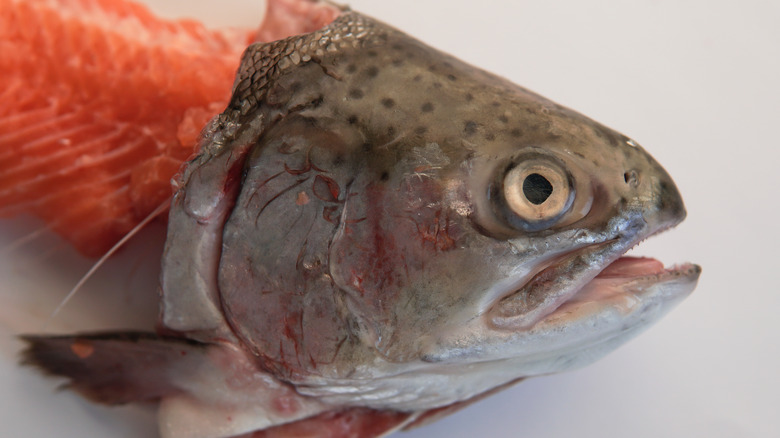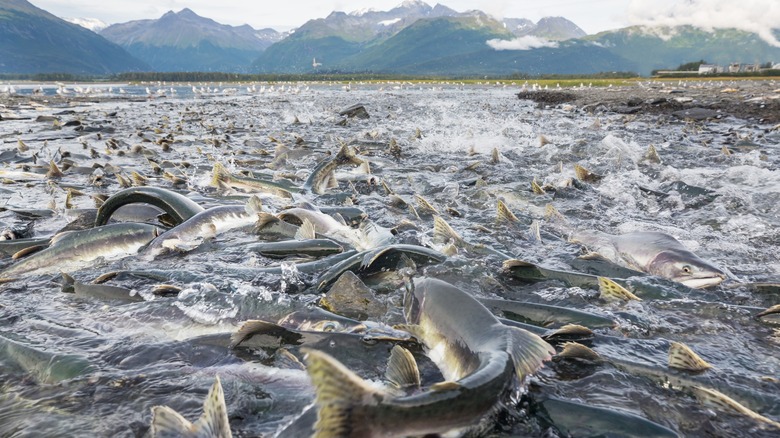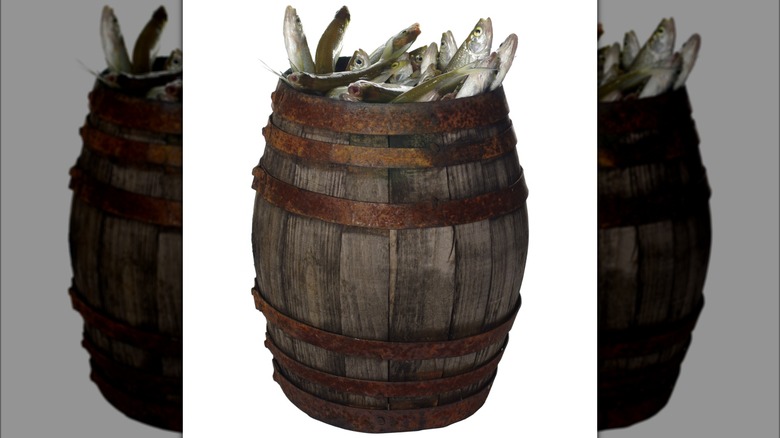Stinkheads Are The Fermented Delicacy That Smell Exactly How They Sound
Fermentation has been a part of the human diet for millennia. The purpose of the process has always been to improve flavor, preserve food, or both. This technique has led to many beloved fermented dishes like sourdough bread, yogurt, miso, kimchi, and countless others across the globe. It's also responsible for some powerfully-scented foods like stinkheads, which are basically exactly what they sound like. They could be compared to hákarl, the pungent meat that Anthony Bourdain refused to eat ever again.
An indigenous Alaskan delicacy, stinkheads are the heads of fish (usually salmon) that have been buried and are naturally fermented underground before they are eaten. As you can imagine, the odor they emit is intense because bacteria break the flesh down in the absence of refrigeration, making the dish one that might be best reserved for foodie daredevils. Stinkheads were a staple in the diet of the Alaskan Inuit and Yup'ik communities. They were mostly prepared in the summertime when salmon numbers were at their highest. Today, the dish is considered a delicacy and remains an important traditional food for Indigenous Alaskans.
The beginnings of stinkheads
Alaska is known for its stunning natural beauty, wildlife, and for sometimes being unforgiving when it comes to the weather. Whether native people were utilizing animals to make winter clothing or discovering new ways to keep their fresh food edible during the warm months, they proved brilliant at surviving and thriving. Utilizing every part of an animal, whether for food, clothing, or shelter, was just one way early Alaskans got the most out of their natural resources. Although they don't contain a ton of meat, fish heads still hold nutritional value, and the Inuit and Yupik people found a way to preserve them, thus creating stinkheads.
Since these communities couldn't freeze large catches of fish in the summer, they turned to fermentation instead, which allowed them to keep this perishable food source for longer periods of time. The process of producing stinkheads is a meticulous one, since this kind of preservation could result in the growth of dangerous bacteria like botulism if done inccorrectly. Extreme attention and care must be taken to avoid the potentially deadly illness; the fact that Alaskan natives have been making successful batches of the dish for generations is a testament to their expertise.
How they are prepared
The traditional way of preparing stinkheads involved removing the heads from fish and placing them in wooden barrels. The barrels were then wrapped in burlap to keep oxygen levels at a minimum, which was a crucial factor in fermenting the fish heads without spoiling them. The barrels were placed underground and buried for around a week, depending on the weather and temperature. It seems that the "doneness" factor of stinkheads was ultimately based on the expertise of the person or people making them. This was likely determined by such things as smell, appearance, and texture. The entire head should turn into a mush-like consistency, even the bones.
Today, stinkheads are prepared in much the same way they have been for hundreds of years, except some will opt for using plastic bags or covered containers rather than wooden barrels. However, some people argue that using plastic increases the potential for dangerous bacteria like botulism. Ultimately, the risk of botulism can be minimized by ensuring safe temperatures and correct pH levels are maintained in the fermentation process. However, unless you have been taught by an expert, it's not a particularly safe or good idea to try this sort of fermentation yourself.
In a way, traditionally preparing stinkheads might be one of the earliest examples of molecular gastronomy, but without the fancy foams and powders. With stinkheads, nature and chemistry do all the work on their own, with a traditional craftsperson overseeing the process instead of a Michelin-starred chef.


